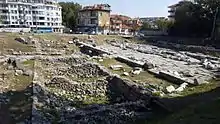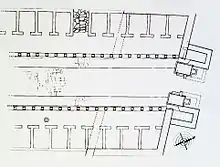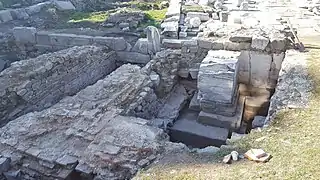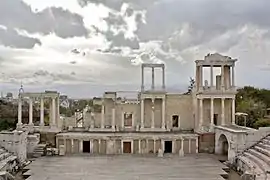Eastern gate of Philippopolis
The Eastern gate of Philippopolis is one of the three entrances of the ancient city that have been discovered in Plovdiv. The gate was built on the main road to Byzantium and the Bosphorus. Initially constructed in the 2nd century AD during the reign of Hadrian, the gate and the complex around it were completely rebuilt in the 4th century, and partially repaired in the 5th century. The Eastern gate was discovered in the 1970s.
 | |
 Eastern Gate of Philippopolis Shown within Plovdiv City Center | |
| Location | Plovdiv, Bulgaria |
|---|---|
| Coordinates | 42.148811°N 24.755862°E |
| Type | Gate |
| History | |
| Founded | 2-4th century AD |
| Periods | Antiquity |
| Site notes | |
| Excavation dates | 1970s |
The Gate

After it was rebuilt in the 4th century, the Eastern gate of Philippopolis had one wide central entrance and two narrower side entrances. Two watch towers were built on both sides of the gate for protection during attacks. The gate was built on the widest and most elaborate street of the city which was partly discovered during the archeological works.[1] The 13 meters wide street was covered with large syenite slabs with paved sidewalk on both sides (each 2.6 m wide) unlike any other street in Philippopolis. Richly decorated colonnade in the Roman Corinthian order was aligned on both sides of the street. Wheel ruts can be seen on the syenite pavement indicating busy cart traffic through the gate. Buildings built in the 4th century with elaborate porticoes in the Corinthian style were found on both sides of the Eastern gate.[2] It is presumed that they were either barracks or infirmary, but their purpose is still debatable. Together with the Eastern gate they formed an entire complex.
- Ruins of the Gate



History
| Part of a series on the ancient city of |
| Philippopolis |
|---|
 |
| Buildings and structures |
|
Religious
Fortification
Residential
|
| Related topics |
| • History • Timeline |
The first structure on the place of the today's Eastern gate was a marble triumphal arch built on the main road to Byzantium in the 2nd century for Hadrian's visit in Philippopolis. Later, Emperor Marcus Aurelius started building fortification facilities in the region given the danger of Marcomannic invasion. As a result, Philippopolis was encircled by a stone wall in 172. The memorable arch was left defenseless a few dozen meters outside the fortified area where the first eastern gate was built. After Philippopolis recovered from the destruction of the Goth invasion in 251, the old fortress walls were torn down and new fortification of bricks and stone was built. The new Eastern gate of Philippopolis was built over the ruins of Hadrian's arch. The builders used the remaining stones and decorations of the old monument when constructing the new city gate.[3] The memorial of the imperial visit from the 2nd century became the biggest and the most important entrance of Philippopolis.
Gallery
 General view of the complex
General view of the complex Marble fundament of the gate
Marble fundament of the gate Stone fundament of the gate
Stone fundament of the gate Ruins of the stone walls and the watch towers
Ruins of the stone walls and the watch towers Detail from the arcade
Detail from the arcade Corinthian capital
Corinthian capital Details from the architrave
Details from the architrave Ruins of the barracks
Ruins of the barracks The street leading to the Eastern gate
The street leading to the Eastern gate Full size columns
Full size columns

